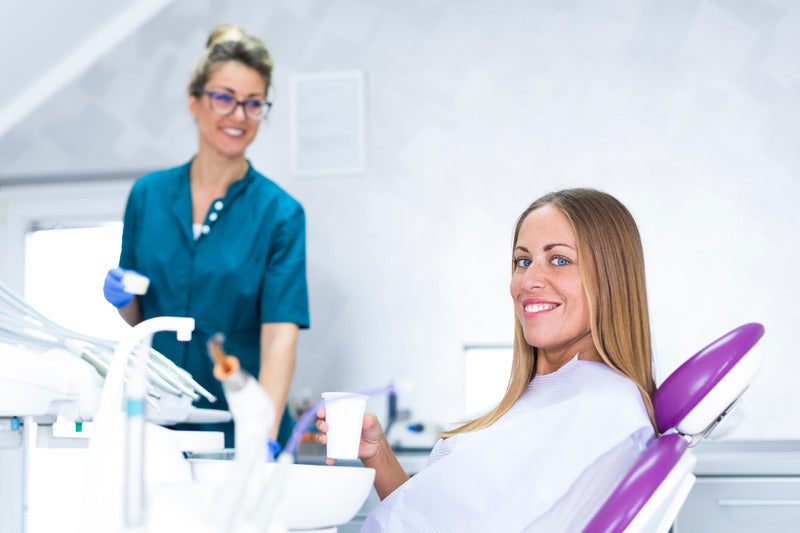
Chlorhexidine Rinses: What are the Alternatives?
Share
Chlorhexidine is one of the longest-standing antiseptics on the market and was introduced to the medical community in the 1950s. It’s still used in clinical environments to disinfect the skin (both that of the patient and surgeon) for surgery prep. It can also be an effective method to clean surgical instruments, wounds, and certain mouth infections.
While it was widely prescribed for oral use, it’s largely been phased out. Patients of a certain age are likely familiar with its metallic taste and unfortunate stains that then have to be cleaned by a hygienist after use.
Still, many dental offices continue to prescribe rinses with chlorhexidine to prevent gingivitis. Beyond those side effects, as an oral rinse, it is dangerous for children and comes with a host of side effects.
What are some alternatives to chlorhexidine and where can you find them?
The Side Effects of Chlorhexidine
Patients looking for an alternative to chlorhexidine are typically concerned about side effects. While rare, it can cause severe allergic reactions in some patients, whether it’s used topically or orally. Per the Food and Drug Administration (FDA), “Symptoms include wheezing or difficulty breathing; swelling of the face; hives that can quickly progress to more serious symptoms; severe rash; or shock, which is a life-threatening condition that occurs when the body is not getting enough blood flow.”
In 2017, the FDA required special labeling for all over-the-counter medications and products containing chlorhexidine, warning of those allergic reactions. While there were fewer than 100 cases of such reactions reported to the FDA, the agency states that “there are likely additional cases about which we are unaware.”
Dental patients often fail to remain compliant with rinse subscriptions containing chlorhexidine for several reasons, including the unpleasant taste, teeth staining, and calculus buildup. There are also ongoing concerns about its efficacy. Because the substance is inactivated so easily, the prescribed usage is very difficult to follow. Patients are far more likely to use an oral product if it can be used immediately after brushing (rather than the prescribed 30 minutes after use of other dental products).
Most troubling, chlorhexidine was linked to disrupting the healing process in gum patients, and has been nearly phased out of all endodontics entirely. Because it was never created for oral applications, most dental and oral health professionals have already been turning to other solutions for implants and scaling procedures in the office.
What are the best alternatives to chlorhexidine for patients who need to treat gingivitis once they leave the office?
Other Impactful Antibacterial Agents
Chlorhexidine as an oral health product has always been off-label use. Intended as a topical antiseptic, in the 1950s, there simply were only a handful of antibacterial agents available. Today, there are several ingredients and products that not only kill the bacteria that causes gingivitis, but are also easier, safer, and more effective.
For example, cetylpyridinium chloride is also an effective antiseptic. Also known as cetyl chloride, it’s an effective treatment for both gum disease and to prevent plaque buildup. It has broad antibacterial properties, and is now widely used in oral rinses, breath sprays, nasal sprays, and toothpastes. In clinical studies, it’s also shown to have a negligible impact or reaction on patients.
With the lack of risk, staining, or a metallic aftertaste, patients are also far more likely to remain compliant. If used properly, rinses containing cetyl chloride are long-lasting and can be used during a patient’s normal oral hygiene routine.
SmartMouth™ Oral Rinse is a Safe, Effective Alternative to Chlorhexidine
SmartMouth™ Clinical DDS Activated Oral Rinse combines impactful, safe, and—more importantly—side effect-free ingredients to prevent gingivitis, plaque, and bleeding gums.
It’s a safe, OTC substitute for a prescription chlorhexidine rinse. Because of our patented formula, unlike prescription chlorhexidine, SmartMouth:
- Contains zero alcohol, to minimize aftertaste
- Will not cause chlorhexidine staining
- Is paraben free
- Does not lead to calculus buildup
Activated Zinc Ion Solution Effectively Manages Bad Breath
Zinc ion technology and our patented solution promote oral health and keep bad breath at bay for up to 12 hours per rinse. SmartMouth was shown to be effective at preventing bad breath in clinical studies.
One such recent study conducted by Saint Louis University Center for Advanced Dental Education and the Southern Illinois University School of Dental medicine compared a 0.12% chlorhexidine rinse to SmartMouth Clinical Advanced Formula. The results were compelling, especially for patients.
Smart Mouth Clinical DDS outperformed the other prescription rinse in reducing gingival inflammation bleeding and plaque.
How Does it Work?
The mixing process activates the zinc ions, which then attach to the germs, which in turn prevents bad breath. In addition, our patented sulfur eliminating solution prevents the buildup of sulfur gases, immediately getting rid of bad breath.
Our easy-to-use packaging ensures that elderly or non-compliant patients will be able to use the mix at home.
If you and your staff are interested in promoting our safe and effective OTC antibacterial dental rinse to your patients, contact us today to receive patient handouts or more information for our professional program.
